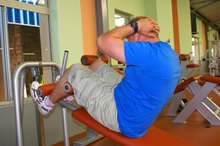If You Have Muscular Dystrophy, What Is a Good Exercise Routine?
Muscular dystrophy, MD, is a condition in which the muscles in the body are weakened. Exercise can provide many benefits to those suffering from MD, although it is not appropriate for everyone with MD. Exercise appears to be safe and effective for “slowly progressive muscular dystrophies,” according to Ted Abresch, director of the Research and Training Center for Neuromuscular Disease at the University of California Davis. For this reason, it is recommended you speak with your doctor before beginning an exercise program if you have MD.
Aerobic Exercise
Aerobic exercise improves heart and lung function, endurance and quality of life as well as promoting weight loss. Moderate-intensity aerobic exercise, or about 65 percent of maximum heart rate, is generally accepted as safe for most individuals with MD. At this intensity, you should be able to exercise and talk at the same time. If you're not, you are probably exercising too hard. Low-impact forms of aerobic exercise are best, such as walking, swimming or biking. The American College of Sports Medicine, ACSM, recommends exercising for at least 20 minutes, four to six times a week. If you have low endurance, you may start with five-minute sessions or break up your workouts into several shorter sessions spread throughout the day.
- Aerobic exercise improves heart and lung function, endurance and quality of life as well as promoting weight loss.
- The American College of Sports Medicine, ACSM, recommends exercising for at least 20 minutes, four to six times a week.
Strength Training
Exercise Precautions & Contraindications in Rheumatoid Arthritis
Learn More
Strength training targets the main symptom of muscular dystrophy – muscle weakness. Strength training is safe for individuals with limited muscle damage; however, to avoid further injury to the muscle, a light-weight, high-repetition strength training program should be followed. When you begin lifting weights, start with only five to 10 repetitions of each exercise. Then gradually increase the number of repetitions and sets, with the goal of eight to 12 repetitions and three sets of each exercise, performed three times a week. Weights should be kept within the 5- to 10 lb. range and may be increased gradually, provided you are able to lift the previous weight without difficulty.
- Strength training targets the main symptom of muscular dystrophy – muscle weakness.
- Strength training is safe for individuals with limited muscle damage; however, to avoid further injury to the muscle, a light-weight, high-repetition strength training program should be followed.
Stretching
A stretching program provides several benefits including improved flexibility, reduced stiffness of the muscles and increased range of motion of the joints. A proper warm-up should precede stretching to help loosen muscles and reduce the risk of injury to the muscles. Stretches should center on the primary muscles affected by stiffness as well as other large muscle groups. Try to complete three sets of 10- to 30-second holds for each exercise. Stretches should be repeated three to four times a day and ideally be done every day to provide the greatest benefit.
- A stretching program provides several benefits including improved flexibility, reduced stiffness of the muscles and increased range of motion of the joints.
- A proper warm-up should precede stretching to help loosen muscles and reduce the risk of injury to the muscles.
Considerations
How Does Blood Pressure Respond to Isometric Exercise?
Learn More
Talk to your doctor before beginning an exercise routine if you have MD. Since MD weakens the skeletal muscles, there is a risk for damage to muscles with exercise, especially if you lift more weight than your muscles can tolerate. The adage “no pain, no gain” does not apply to MD. While exercise can reduce muscle pain associated with MD, severe muscle pain suggests that damage has occurred. In this case, cessation or reduction in the frequency, intensity or duration of the exercise is warranted. Many individuals with MD also have cardiac involvement that makes aerobic exercise dangerous, such as heart arrhythmias or heart failure. Proper cardiac clearance by a physician is particularly essential for these individuals prior to exercise.
- Talk to your doctor before beginning an exercise routine if you have MD.
- Since MD weakens the skeletal muscles, there is a risk for damage to muscles with exercise, especially if you lift more weight than your muscles can tolerate.
Related Articles
References
Writer Bio
Kimberly Rienecke started her career as a health and fitness writer by working for various websites. She is a certified orthopedic physician assistant and an ACE-certified personal trainer. She also holds a Bachelor of Science in biology from Towson University.









